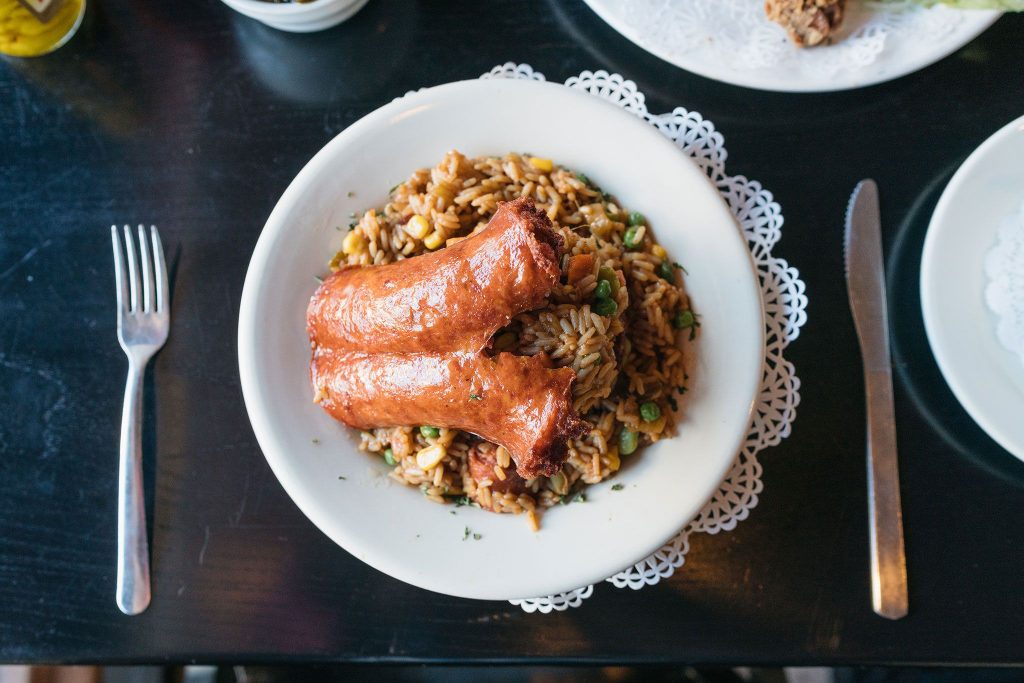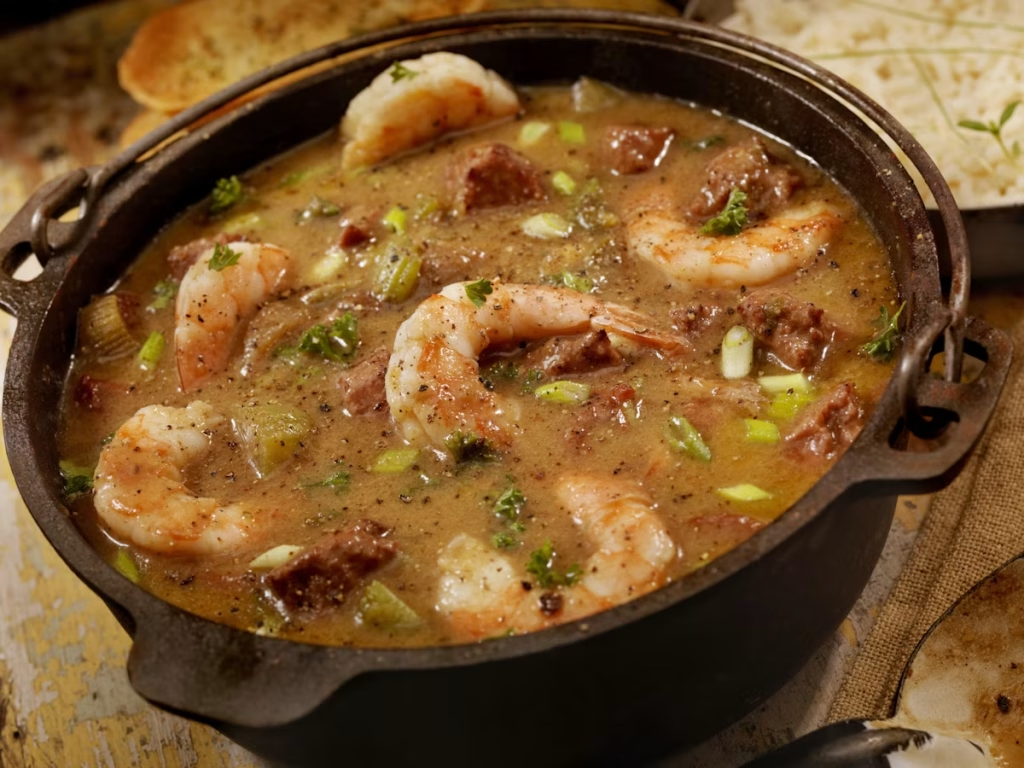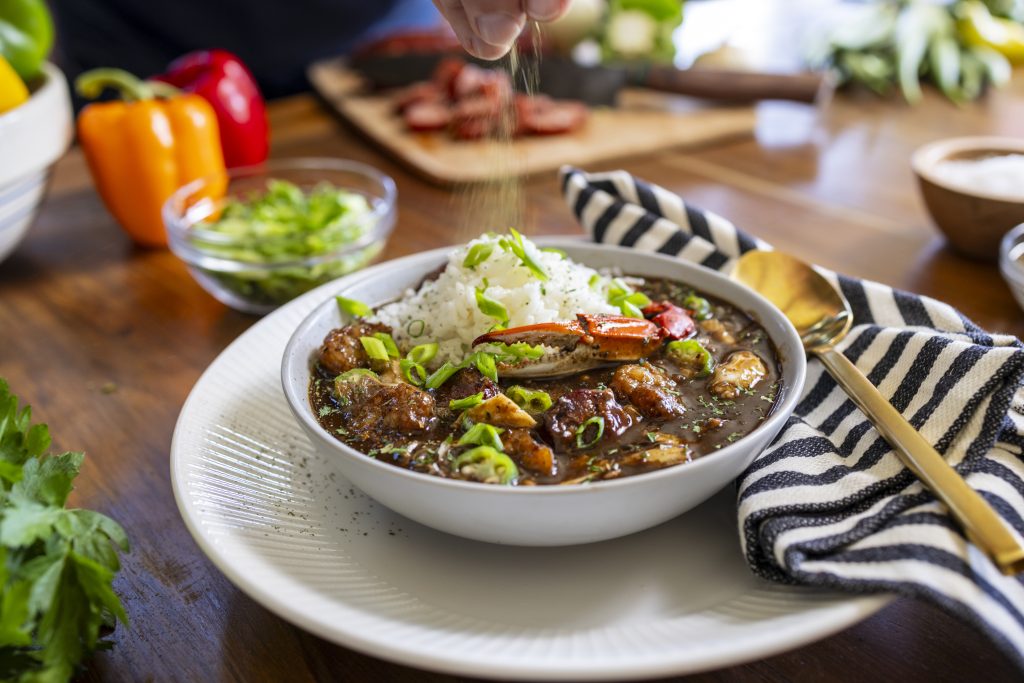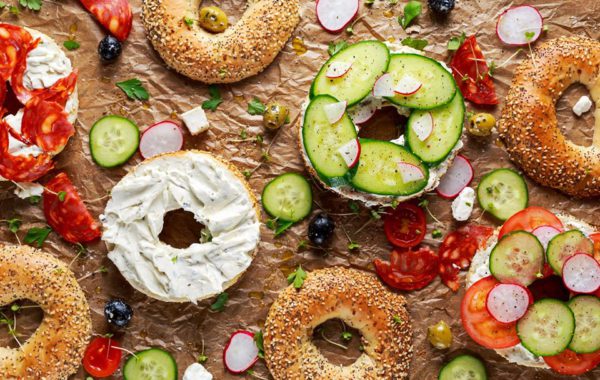From gumbos and jambalayas to beignets and king cakes , take a delicious journey through the soulful, spicy, and storied dishes that define New Orleans—one unforgettable bite at a time.
The first time I wandered through the French Quarter, I felt like I had stepped into a vivid dream stitched together with wrought-iron balconies, cobbled lanes, and the soft hum of a jazz trumpet drifting out of a hidden courtyard. The street names — Rue Bourbon, Rue Chartres — whispered of France, and the scent of pralines, café au lait, and powdered sugar danced through the air like a sweet spell. It was unmistakably French, or so I thought. But New Orleans doesn’t just wear one identity. It swirls with something deeper — something called Creole — and if you want to understand it, you must taste it.
Creole food in New Orleans is more than cuisine—it’s culture on a plate. A rich fusion of French, Spanish, African, Caribbean, and Native American influences, it’s elegant, city-born, and globally inspired. You’ll taste it in every spoonful of gumbo and bite of jambalaya.
Cajun cuisine, on the other hand, comes from the French-speaking Acadians who resettled in rural Louisiana after being exiled from Canada. Their dishes—bold, rustic, and rooted in survival—reflect the hearty spirit of Acadiana, where spice and soul go hand in hand.

Ask a local where to find the best gumbo in town, and you might spark a passionate debate that quickly spirals into a lesson on culture, identity, and centuries of migration.
To understand the difference, follow the roux. Creole gumbo often begins with a lighter, golden base, brightened by tomatoes and thickened with okra — a nod to its West African roots. It’s not uncommon to find shrimp dancing alongside sausage or chicken in the same pot, a blend as cosmopolitan as the city itself. Cajun gumbo, by contrast, leans darker and smokier, often skipping tomatoes altogether and letting a deeply browned roux carry the weight. The result is rustic, punchy, and pure Acadiana.
But don’t mistake these as opposing camps. Over generations, Creole and Cajun communities have shared tables, traded spices, and borrowed freely — from German sausages to Italian red sauce — to create what we now know as Louisiana cuisine. It’s a cuisine where no recipe is static, and no pot stays unshaken.

At the center of it all is that unshakable joie de vivre — the belief that food is not just nourishment, but celebration.
The A to Z of New Orleans Cuisine: Where to Eat, What to Savor, and the Stories Behind Each Bite
New Orleans isn’t just a place you visit — it’s a place you taste. With every bite, the city tells a story of Creole elegance, Cajun resilience, and a melting pot of French, Spanish, African, and Caribbean heritage. This A-to-Z guide celebrates the iconic dishes that make the Crescent City the culinary capital of the South.
A for Alligator
A staple of Cajun cooking, alligator meat surprises the uninitiated with its tender texture and mild, almost chicken-like flavor. It’s often fried or used in sausages, but to really see it shine, head to Red Fish Grill, where the Alligator Sausage & Seafood Gumbo steals the show. Studded with Creole Country sausage, local shrimp, and the holy trinity of onion, celery, and bell pepper, it simmers in a dark roux and lands on your plate with a ladleful of green onion rice.
B for Beignets & Bananas Foster
There are beignets, and then there are New Orleans beignets—pillowy pockets of fried dough snowed under with powdered sugar and served hot enough to burn your fingertips. The beating heart of this tradition is Café du Monde in the French Quarter. For a charming alternative, head to Café Beignet, a beloved local gem. Want a savoury twist? Try the Blue Crab Beignets at Restaurant R’evolution—lightly crisped and decadently rich.
Meanwhile, Bananas Foster flambés its way into local lore. First ignited at Brennan’s in 1951, this dessert—bananas sautéed in brown sugar, butter, cinnamon, and banana liqueur, then flambéed with rum—remains the restaurant’s most requested dish. Bonus tip: Palace Café, also run by the Brennan family, delivers its own theatrical rendition of this sweet, smoky indulgence.
C for Crawfish
Crawfish are Louisiana’s beloved freshwater delicacy—small, clawed crustaceans that pack bold flavor and local pride. In New Orleans, they’re everywhere: smothered in rich étouffée, baked into cheesy crawfish bread, or boiled in fiery seasoning until bright red and irresistible. From street food to fine dining, these little crustaceans deliver Southern flair in every form—sautéed, fried, or folded into brunch favorites like the decadent crawfish omelette at Café Beignet. Feeling extra indulgent? Head to Deanie’s Seafood for their legendary Seafood Platter—a heaping medley of fried shrimp, oysters, catfish, soft shell crab, crawfish balls, and crisp French fries, perfect for sharing or not.
D for Doberge Cake
Inspired by Hungary’s Dobos torte, the Doberge cake is a local legend: six to eight layers of cake and custard wrapped in buttercream and ganache. Gambino’s Bakery keeps the original chocolate and lemon flavors alive, while Debbie Does Doberge at Bakery Bar reinvents them with playful twists and boozy variations.
E for Étouffée & Eggs Sardou
“Smothered” is the magic word here. Étouffée—slow-simmered shellfish, roux, and spices served over rice—is a Creole-Cajun staple. Local favorites include Jacques-Imo’s Cafe and Gumbo Shop, both ladling out soul-hugging renditions.
Eggs Sardou, born at Antoine’s, is brunch at its most baroque: poached eggs perched on artichoke hearts, nestled in creamed spinach, and lavished with hollandaise. Named after playwright Victorien Sardou, it’s as theatrical as it sounds.
F for Fried Seafood
In New Orleans, fried seafood isn’t just a dish—it’s a deep-fried devotion. Straight from the Gulf and seasoned with flair, it’s the kind of meal that needs no excuse, though it shines brightest during Lent or any weekend worth celebrating. From flaky catfish to crisp oysters, the city’s fryers deliver golden perfection in every bite. Order the overflowing seafood platter at Mandina’s for a classic neighborhood feast, or indulge in the elegant Gulf Fish Amandine at Arnaud’s—crusted with almonds and drizzled in lemon butter.
G for Gumbo
If New Orleans had a scent, it might just be the slow, smoky perfume of gumbo bubbling away in a well-worn pot. Equal parts tradition, debate, and culinary jazz, gumbo is more than a dish—it’s a cultural emblem with roots stretching from French kitchens to West African hearths. Built on a deep, dark roux (that magic blend of flour and fat), and layered with the “holy trinity” of onion, celery, and bell pepper, every gumbo is a statement.
Some versions shimmer with okra and filé powder; others are brimming with Gulf shrimp, blue crab, and spicy andouille sausage. Start at Deanie’s Seafood , where the okra gumbo arrives rich, bold, and brimming with fresh catch. At the Gumbo Shop, the house specialty has earned its accolades with generous lumps of crab and a just-spicy-enough broth. Or head to Oceana Grill, where seafood gumbo comes loaded with shrimp, depth, and stories. In New Orleans, gumbo isn’t just served—it’s shared, debated, and savored.
H for Hot Sauce and Hurricane
In New Orleans, hot sauce isn’t just a condiment — it’s a culinary rite of passage. It adds swagger to gumbo, punch to po’ boys, and a smoky burn that lingers like a good jazz riff. Spice hunters should make a beeline for Pepper Palace, a flavor emporium with over a thousand fiery bottles lining its walls. Taste your way through everything from habanero jams to ghost pepper salsas — even the infamous “Hottest Sauce in the Universe: 2nd Dimension,” which requires a waiver before sampling. If you’re feeling brave, try the cinnamon-habanero blend — surprisingly sublime over vanilla ice cream.
Bold, boozy, and unapologetically sweet, the Hurricane is New Orleans in a glass—lively, colorful, and just a little wild. Born at Pat O’Brien’s during World War II, when rum was plentiful and whiskey scarce, this fruit-forward cocktail took its name from the curvy hurricane lamp-shaped glass it’s famously served in. A swirl of light and dark rum, passion fruit, citrus, and grenadine, it’s more than a drink—it’s a rite of passage in the French Quarter. Just one word of advice: sip slowly.
I for Ice Cream at Angelo Brocato’s
Since 1905, Angelo Brocato’s has been a sanctuary for lovers of gelato and Sicilian sweets. From nutty pistachio to liqueur-laced spumoni, the flavors here are old-world perfection. Don’t miss the cannoli, filled to order and dusted with sugar, or the icy lemon granita on a sultry day.
J for Jambalaya
A soulful echo of Spanish paella, Jambalaya is New Orleans in a bowl—hearty, spicy, and unapologetically bold. A fragrant medley of rice, sausage, seafood, chicken, and the holy trinity of Creole cooking (onion, bell pepper, celery), it’s a dish that tells a story with every spoonful. For a classic version with old-world charm, head to Napoleon House, where the Jambalaya pairs beautifully with their signature Pimm’s Cup — a crisp, citrusy cocktail layered with Pimm’s No.1, lemonade, cucumber, and mint. Other standout spots include Brennan’s for a refined Creole take, and Coop’s Place or The Gumbo Shop for rustic, flavor-packed renditions locals swear by.
K for King Cake
No Mardi Gras celebration is complete without king cake. This iconic, ring-shaped pastry is topped with colorful purple, green, and gold sugar, symbolizing justice, faith, and power. The cake varies from simple cinnamon brioche to decadent versions stuffed with fillings like praline cream, chocolate, and even Vietnamese coffee flavors. A plastic baby is hidden inside, and tradition dictates that whoever finds it must buy the next king cake. Among the most sought-after is Dong Phuong Bakery & Restaurant, a James Beard Award-winning gem known for its perfectly crafted, sweet confections. During Carnival season, it ships thousands of king cakes across the country, bringing a taste of Mardi Gras to hos nationwide. Swiss Confectionery and Brennan’s, also offer inventive takes from strawberry to bananas foster.
Pronounced “lan-yap,” this charming Creole term means “a little something extra”—a free amuse-bouche, a surprise dessert, or even a chef’s extra flourish. In New Orleans, generosity is baked into the culture, and lagniappe is its edible signature. Expect it. Appreciate it.
M is for Muffaletta
No visit to New Orleans is complete without biting into a muffaletta—a bold, briny Italian sandwich born in the heart of the French Quarter. Layered with cured meats like salami and ham, slices of provolone, and a punchy olive salad of chopped olives, garlic, and spices, it’s all tucked inside a giant, sesame-studded round loaf meant for sharing—or not. This legendary sandwich was introduced in 1906 by Sicilian immigrant Lupo Salvadore at Central Grocery and Deli, where the original recipe is still served, wrapped in wax paper and bursting with flavor. For a twist, Napoleon House serves theirs warm, with house-made bread and a melty, olive-packed filling that turns a street food classic into something sublime.
N for Natchitoches Meat Pies
Golden, crispy, and irresistibly spiced, Natchitoches meat pies are Louisiana’s answer to the empanada—filled with a rich blend of beef, pork, and Creole seasoning. A nod to Native American and Spanish roots, they’re a street food staple and a Jazz Fest favorite. For a perfect bite in the French Quarter, head to The Original Pierre Maspero’s, where they’re served hot, flaky, and full of flavor.
.
O for Oysters
New Orleans oysters are big, briny, and celebrated. Try them raw, baked, or chargrilled. Antoine’s invented the breadcrumb-and-spinach-topped Oysters Rockefeller in 1889. At Red Fish Grill, BBQ oysters are tossed in spicy Crystal sauce. For a sandwich spin, try a fried oyster po’boy at Domilise’s or Mahony’s. Saffron NOLA adds an Indian twist with its oyster bed roast.
P for Po’ Boys
Messy, meaty, and undeniably magnificent—the po’ boy is New Orleans’ most beloved sandwich. Tucked into crispy French bread and piled high with fillings like roast beef, fried shrimp, oysters, or even surf-and-turf, it’s finished with lettuce, tomato, pickles, and a slather of mayo or gravy. Locals will debate loyalties, but Parkway Bakery & Tavern in Mid-City remains a reigning favorite. Open since 1911, it’s famous for its fried shrimp po’ boy and gravy-drenched roast beef. Don’t miss their seasonal Thanksgiving version—or the rare corned beef brisket.
Q for Quail
Quail brings a taste of Louisiana’s hunting traditions to the table, often roasted, grilled, or stuffed with bold Southern flavors. For the city’s most unforgettable take, head to Restaurant R’evolution for Death by Gumbo—a near-boneless quail filled with oysters, andouille sausage, and herbed rice, all steeped in a rich, smoky gumbo. It’s dramatic, decadent, and absolutely worth the name.
R for Red Beans & Rice
A Monday staple born from tradition and thrift, red beans and rice simmered while laundry was scrubbed—slow-cooked comfort with deep Creole roots. Spiced with bay leaf, thyme, and a whisper of cayenne, the dish often features sausage or ham hock for richness. For a classic bowl, try Napoleon House, where it’s served with smoked sausage and crusty French bread. Or cozy up at Café Beignet, where the beans are creamy, the portions generous, and the vibe pure New Orleans.
S for Sazerac & Sno-Balls
Equal parts elegance and edge, the Sazerac is New Orleans’ signature cocktail—bold with rye whiskey, kissed with absinthe, and rounded out with Peychaud’s bitters. It’s history in a glass, best sipped at The Roosevelt’s Sazerac Bar where tradition meets style.
On the sweeter side, sno-balls are the city’s nostalgic treat—pillowy shaved ice drenched in syrupy flavors like wedding cake or wild strawberry. Find them at local gems like Hansen’s Sno-Bliz or roadside stands citywide, perfect for cooling down after a stroll through the Quarter or a lazy afternoon in City Park.
T for Turtle Soup
A true Creole delicacy, turtle soup is rich, refined, and unmistakably New Orleans. Thickened with dark roux and simmered with herbs, vegetables, and tender turtle meat, it’s traditionally finished with a splash of sherry tableside. Commander’s Palace is the gold standard, serving their famed version with ceremony and soul. For equally beloved renditions, stop by Brennan’s, Mandina’s, or Mr. Ed’s, where this storied dish continues to charm locals and first-timers alike.
U for United Houma Nation
At the crossroads of culture and cuisine, the United Houma Nation brings Indigenous Louisiana flavors to the forefront. As the state’s largest tribe, they’re a beloved fixture at the New Orleans Jazz & Heritage Festival, where their stall draws crowds with golden fry bread, hearty Indian tacos, smoky corn maque choux, and strawberry-sweet potato fry bread blossoms that blur the line between comfort food and art.
V for Vieux Carré and Vampire Apothecary
Named for the French Quarter, the Vieux Carré is a 1930s cocktail born at Hotel Monteleone. Equal parts rye, cognac, and sweet vermouth, it’s bold, smooth, and best enjoyed at the Carousel Bar, which slowly rotates as you sip.
Dark, decadent, and just the right amount of dangerous—Vampire Apothecary is where gothic fantasy and gourmet indulgence collide. This vampire-themed haunt serves drama by the goblet, with cocktails like the signature Blood Bag (vodka, pomegranate, lemon) delivered in hospital-style IV pouches. The menu is as eclectic as it is indulgent—fresh oysters, toasted panini, roasted quail, crawfish boil, and baked salmon cooked to perfection. Between sips and bites, guests can peek into the beyond with tarot and tea leaf readings, or take home a custom-fitted pair of fangs. It’s part bar, part séance, all spectacle.
W for White Chocolate Bread Pudding
Housed in a grand Art Deco building on Canal Street, Palace Café blends old-world elegance with contemporary Creole flair. While the menu is filled with standouts, it’s the white chocolate bread pudding that’s become a signature indulgence. Laced with melted white chocolate in both the custard and the drizzle, it’s warm, velvety, and unapologetically rich—the kind of dessert that justifies skipping the entrée.
X for X’mas Réveillon
Imported from French Catholic tradition, Réveillon dinners mark the festive season with opulence. Think turtle soup, duck gumbo, cassoulet, and bûche de Noël. At Ralph’s on the Park, rich duck and andouille gumbo is a festive staple during Réveillon season—a holiday tradition reimagined with Creole flair. Over at the legendary Antoine’s, generations have savored lobster bisque and golden-crisp duck beneath its storied chandeliers. And at Commander’s Palace, the Réveillon menu is ever-evolving—equal parts homage and haute cuisine.
Y for Yam
In Louisiana, yams are sweet potatoes with swagger—locally grown, sugar-rich, and deeply Southern. From candied yams to creamy casseroles, they shine in soulful side dishes across the city. At Lil Dizzy’s Café, the candied yams with mustard greens and bacon are a daily staple—rich, savory, and unmistakably New Orleans.
Z for Z’herbes Gumbo
Once a humble Lenten dish, Gumbo Z’herbes has grown into a once-a-year ritual in New Orleans. On Holy Thursday, locals flock to Dooky Chase’s for the legendary version, brimming with a dark roux, smoked meats, and an herbaceous mix of at least seven greens. It’s not just food—it’s faith, flavor, and family tradition in a bowl.
To dine in New Orleans is to savor a city that revels in flavor, memory, and reinvention. So come hungry, come curious — and don’t be surprised if your first bowl of gumbo tells you more than any history book ever could.
For more information, visit the Official New Orleans Tourism Website
For latest travel news and updates, food and drink journeys, restaurant features, and more, like us on Facebook or follow us on Instagram. Read more on Travel and Food Network
Related Coverage
The Ultimate First-Timer’s Guide to Mardi Gras in New Orleans – Insider Tips & Tricks
Your Travel Guide To New Orleans, Louisiana: The Ultimate 3-Day Itinerary
A New Yorker at heart, an unapologetic anglophile, national parks explorer and former head of National Geographic publishing in India, Ritika is the Global Editor for Travel and Food Network and leads all journalism across platforms, including news, digital, videos, and social media. She writes features focused on narrative storytelling, industry trends, destinations, culinary travel, and how-to advice and is an advocate for sustainable travel. You can follow her on Instagram @newyorkeratheart























